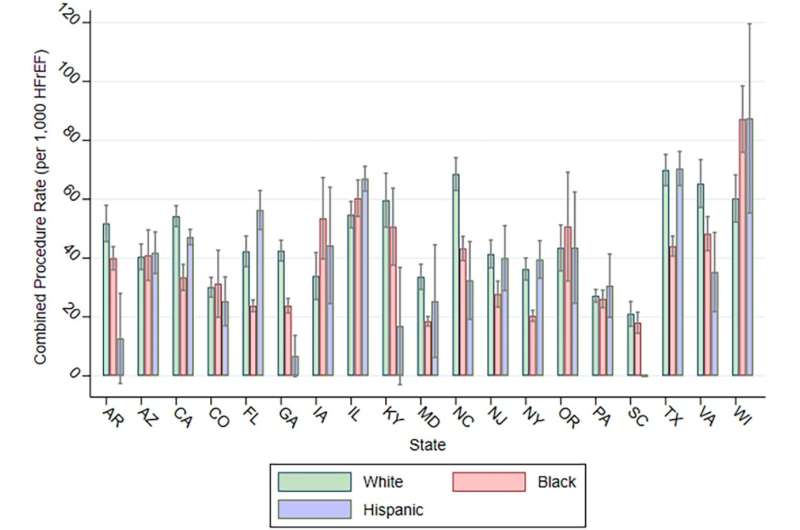This article has been reviewed according to Science X's editorial process and policies. Editors have highlighted the following attributes while ensuring the content's credibility:
fact-checked
peer-reviewed publication
trusted source
proofread
Women, Black men less likely to receive lifesaving heart failure treatments: Study

Access to potentially lifesaving heart failure treatments has increased in recent years, but women and Black men remain far less likely to receive them, new research suggests.
The study, published Wednesday in the Journal of the American Heart Association, found racial and gender disparities in who receives advanced treatments for a type of heart failure called heart failure with reduced ejection fraction, or HFrEF.
"Among women and Black men, there is clearly a disparity," said lead study author Dr. Amresh Hanchate, a professor of social sciences and health policy at Wake Forest University School of Medicine in Winston Salem, North Carolina. "But we were surprised to find no difference in the procedures for Black women compared to white women and Hispanic women. The differences were primarily among Black men."
HFrEF occurs when the heart muscle can't pump enough blood, making it difficult to perform daily tasks. Also known as systolic heart failure, it is diagnosed when the left ventricle, the largest of the heart's four chambers, can't push more than 40% of the blood in the chamber out to the rest of the body.
A left ventricular assist device, or LVAD, is a mechanical pump that is surgically implanted to help the heart pump better. It can be a short-term fix, sometimes called a "bridge to transplant," if a heart transplant is needed. But some people may use the pump permanently, especially if they're not good candidates for a transplant.
Researchers analyzed pooled census, medical and survey data from 2010 to 2018 from 19 states representing 67% of the U.S. adult population, including 85% of the Hispanic and 70% of the Black populations. Among 114.1 million adults ages 35 to 84, an estimated 1.9 million had heart failure. Of the nearly 70,000 with HFrEF, about 44% were women, nearly 30% were Black and about 10% were Hispanic.
Between 2010 and 2018, rates of heart transplant and LVAD use increased steadily among Black, Hispanic and white adults with HFrEF. But the treatment rate among women was about one-third what it was for men. Although Black men had a higher rate of HFrEF, their treatment rates were significantly lower than those for Hispanic or white men.
Women with HFrEF were 72% less likely to receive an LVAD than men and had a 62% lower rate of heart transplant. Black men were 25% less likely to be given an LVAD and had a 46% lower heart transplant rate than their white peers.
Hanchate said prior studies on treatment disparities included all people with heart failure, not just those who would be most in need of advanced therapies. Focusing only on those with HFrEF, he said, allowed his team to arrive at more precise calculations of how treatments were being allocated. But the investigation did not address why women and Black men weren't being treated equitably.
"I'm hoping that this study will provoke people into asking these questions," he said.
Bias among health care professionals who evaluate and refer patients for treatment likely plays a role, said Dr. Monica Colvin, medical director of heart transplants and a professor of medicine in the cardiology division at the University of Michigan in Ann Arbor. "Implicit bias is one possibility. The evaluation for candidacy for advanced therapies can be prone to subjectivity."
Colvin cited a 2020 study in JAMA Network Open in which members of a national heart failure organization were presented with similar clinical data for two sets of patients. The only significant difference among patients was their race. The survey responses showed Black patients were less likely to be referred for heart transplants than their white peers and more likely to be recommended for an LVAD.
"This can be explained by bias," said Colvin, who was not involved in the 2020 study or the new research. "There's no obvious medical basis for this."
Other factors, such as how much support a person has at home to help use devices such as LVADs or to successfully recover from transplants, also may skew the referral process toward men, Colvin said. "Women are often the caregivers in a family, but they are sometimes perceived to be lacking in social support for themselves."
Yet a 2019 study in Circulation: Heart Failure showed women are just as likely to survive a heart transplant as men.
"We have to standardize the referral process to remove subjectivity and provide support for those who need it," Colvin said.
A subsequent study published in JAHA in 2021 found Black people are less likely to get needed heart transplants and more likely to die when they get them.
Failure to refer people for treatment could result in lower survival rates and worse quality of life, Hanchate said, underscoring the need to remove biases from the selection process.
"We need to have guidelines that are much more clear for primary care providers and cardiologists about who should be referred for these procedures and do it in a way that does not implicitly or systematically exclude eligible patients," he said.
More information: Scott W. Rose et al, Disparities by Sex, Race, and Ethnicity in Use of Left Ventricular Assist Devices and Heart Transplants Among Patients With Heart Failure With Reduced Ejection Fraction, Journal of the American Heart Association (2024). DOI: 10.1161/JAHA.123.031021





















